| |



 |
|

Moscow architecture from the 1930s
to the early 1950s undoubtedly occupies a central place in domestic
construction of the socialist epoch. Its specific nature and scope is the
most outstanding illustration of the socialist Utopia in architecture. This
period saw the work of the greatest Soviet architects; B. Icfan, A. Schusev,
I. Zholtovsky, the Vesnin brothers, I. Fomin, L. Rudnev, I. Golosov, V.
Schuko. Among the far-reaching projections of the first Stalinist
"five year plans", the 1935 general plan for the
reconstruction of Moscow overshadowed all others.
According to this plan, Moscow was
to become, in the shortest possible time, the showpiece capital of the
world's first socialist state. The ceneral plan
envisaged the development of the city as a unified system of highways,
squares and embankments with unique buildings, embodying the ideas and
achievements of socialism. This plan contained a number of major flaws,
especially in connection with the preservation of the historical heritage of
the city. The specific nature of the architectural process of this period
was determined wholly by ambitious government schemes.
In order to realize them, extensive
architectural contests were held and architects of diverse orientations and
schools of thought were invited to tender their projects. The competitions
for the projects of the Palace of Soviets (1931-1933) and for the building
of the People's Commissariat of Heavy Industry (1934) were particularly
noteworthy in scope and results. Although, ultimately, neither of these
projects was realised, the plans submitted by the participants had a
noticeable influence on the development of Moscow, and many of the entries
have earned a place in this century's repository of project planning.
At the time, this style of
architecture, like its contemporary literature and Soviet depictive art,
were proclaimed to be an exemplary implementation of the "most progressive"
artistic method of "socialist realism". Considered today, it is clear that
the best examples of this architecture, most of which never got beyond the
drawing board, are more profound and interesting than the ideological norms
within the constraints of which they were devised. Behind many grandiose
projects one may often discern the desires of those endowed with power to
affirm the greatness of this or that historical epoch. May the unrealised
plans of these monumental buildings serve as a reminder that it is right and
proper to build innovatively without destroying the historically valuable
past. That which history has given us, both good and bad, is our undeniable
heritage, and we must accept it as it is. Yet we should not forget the
lessons history has taught us, for upon this hinges the future of Russia.
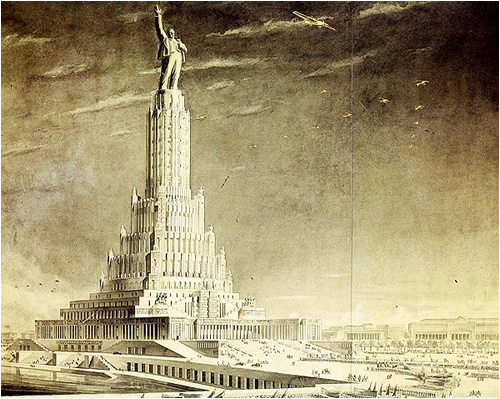
Palace of Soviets. O.Iofan, O.Gelfreikh, V.Schuko.
Sculptor S.Merkulov. A Version of the approved project. 1934
The
competition for the Palace of Soviets in Moscow was one of the most
extensive and impressive of this century. The idea of constructing a
building which could be a symbol of the "imminent triumph of communism" in
the capital of the world's first state of workers and peasants was mooted in
the 1920s. The chosen location was the site of the demolished Church of
Christ the Saviour. The competition was launched in 1931, and carried out in
stages. Overall, 160 entries were submitted, including 24 from foreign
participants. The definitive turn of Soviet architecture toward the heritage
of the past had emerged clearly by that time, and was the key factor in the
choice of winners.
The top awards went to architects G.
Hamilton from the United States, Ivan Sholtovsky and Boris Iofan (who also
designed the Soviet pavilion at the 1937 world exhibition) from Russia.
Iofan designed the winning plan with architects Vladimir Gefreikh and
Vladimir Shchuko.
Atop of the Place of Soviets would
be placed a colossal statue of Lenin. The statue alone would already be
twice as high as the Statue of Liberty in New York. The entire building
would be 495 metres high.
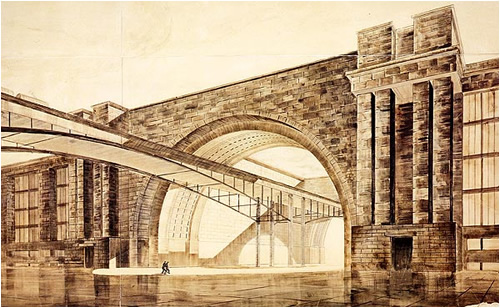
The Рalace of Technology. А.Samoylov, B.Yefomovich.
1933
A competition for a design for the
Palace of Technology was announced in 1933. The project called for a complex
of scientific and technical institutions, it was to be in the the capital
city of a country which was being actively industrialised by a central
administration called upon to "arm the masses with the achievements of
Soviet industrial technology, agriculture, transport and communications". A
site on the banks of the Moskva river was selected as the location of this
Palace. The industrial resolution selected by A. Samoylov and B. Yefimovich
was not a tribute to a constructivisim which was receding into the past, but
rather an illustration of the "technocratic" character of the subject. The
Palace of Technology was never built.
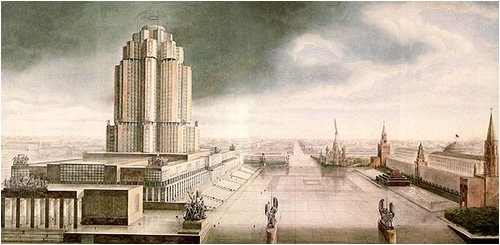
The building of the People's Соmmissariat of Heavy
Industry, A. Vesoin, V, Vesnin, S. Lyaschenko. 1934
A competition for the design of a
building to house the People's Commissariat of Heavy Industry (Narkomtyazhprom)
on Red Square was announced in 1934. The construction of this grandiose
complex of 110,000 m3 on an area of four
hectares would have resulted in a radical reconstruction of Red Square and
adjacent streets and squares of Kitai-Gorod. Twelve entries were submitted
for the first stage of the competition. The impressive plans drawn up by the
brothers A. and V. Vesnin --
leaders of the constructivist movement --
were not noted by the jury, along with a number of other entries,
although the submissions included some of the most interesting architectural
ideas and projections of this century. The building of the People's
Commissariat of Heavy Industry was never realised.
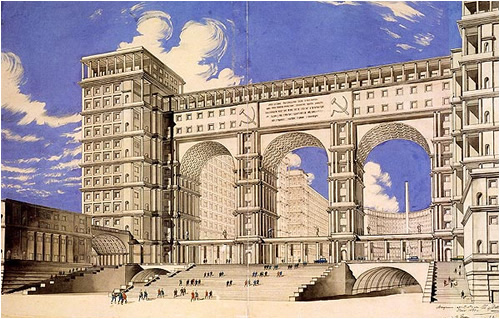
The building of the People's Commissariat of Нeavy
Industry. I.Fomin, P.Abrosimov, M.Minkus. 1934
I.Fomin was a leading representative
of the St. Petersburg neo-classical Russian school of architecture, and had
attained prominence before the revolution. Even in the 1920s, a period
dominated by constructivism, Fomin managed to remain faithful to the
principles of classical architecture and even devised a so-called
"proletarian-order" expressed thus: "the two basic verticals of the main
facade create an aperture which provides a clear view of the mausoleum.
Along Sverdlov Square, the construction finishes with a butt-end. We have
selected the silhouette technique as the solution. The butt-end will be
divided by a very ornate arch to blend with the character of the Square's
old architecture. The building is planned as a closed circle. As the
construction is a closed one, we did not wish to go above 12-13 floors, with
only the tower reaching a height of 24 floors" - extract
from annotations to the project.
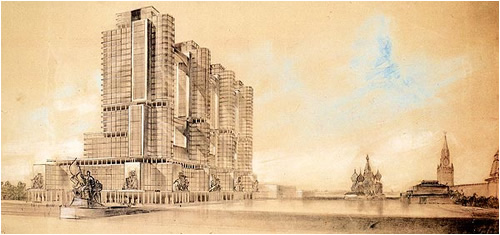
The building of the People's Commissariat of Нeavy
Industry. А.Vesnin, V.Vesnin, S.Lyaschenko. Version. 1934
"...Four towers, up to a height of
160 metres, on a stуlоbate which harmonizes with the Kremlin wall. A
rhythmical construction, expressed in four vertical elements and the
colonnade of the stylobate, creating a visual extension, essential to the
longitudinal framing of the Square and responding to the Kremlin wall. The
vertical divisions correspond to the four divisions of the Kremlin tower and
are necessary for the inclusion of the building into the overall ensemble.
The project envisages a single vestibule the length of Red Square"
- extract from annotations to the project.
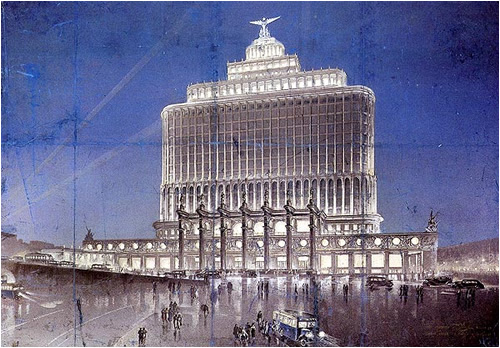
The Aeroflot Building. D.Chechulin. 1934
In 1934, the attention of the whole
world was focused on the fate of the crewmen of the ice-breaker "Chelyuskin",
who were adrift on an ice-floe after the ship went down in the Sea of
Chukotsk. In the summer of the same year Moscow greeted the courageous
survivors and the pilots who had rescued them, and who were the first to be
granted the "Hero of the Soviet Union" award. The new traditions of
socialist life demanded the perpetuation of the memory of this outstanding
feat in monumental form. The "Aeroflot" building, which was to be erected on
the square beside the Byelorussky railway station, was planned by architect
D.Chechulin as a monument to the glory of Soviet aviation. Hence the
sharp-silhouette, "aerodynamic" form of the tall building and the sculpted
figures of the heroic airmen A.Lyapidevsky, S.Levanevsky, V.Mоlоkоv,
N.Kamanin, M.Slepnev, M.Vodopyanov, I.Doronin, crowning seven openwork
arches, perpendicular to the main facade and comprising a distinctive
portal. I.Shadr, the sculptor of the airmen's figures, took part in the
project's design. The project was never realised in its original design or
intention. Almost half a century later, the general ideas of the project
were incorporated into the complex housing the Supreme Soviet of the RSFSR
on thе Кrasnоргеsnenskауа Еmbankment (nоwadауs: Gоvernment
Ноuse).
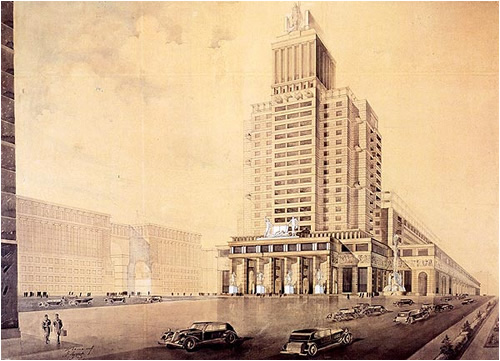
House of Books (Dом Knigi). I.Golosov, P.Antonov,
A.Zhuravlev. 1934
The plan of the House of Books is
typical of early 1930s perceptions of a building as an architectural mоnument.
A trapezоid tall silhouette, simplified architectural forms and an abundance
of sculptures on all parts of the building. Architect I.Golosov achieved
prominence in the constructivist movement in the 1920s (the "textbook" Zuyev
Club was his project), and in subsequent years he found interesting
solutions in the spirit of the new Soviet classicism. He submitted original
projects to the competitions for the House of Soviets and the building of
the People's Commissariat of Heavy Industry. Golosov's work is distinguished
by features which are designated "symbolic romanticism". "The architect must
not be bound by style in the old, historical sense of that word, he himself
must be a creator of style... То this end, it is essential to set guidelines
which facilitate the optimum realisation by the builder of each individual
project... One must establish only absolute tenets, those which are
inevitable, true and unchanging. There are many such, and these tenets, as
vehicles of absolute values, are equally applicable to classical and
contemporary architecture" - I.Golosov,
from his lecture New Paths in Architecture.
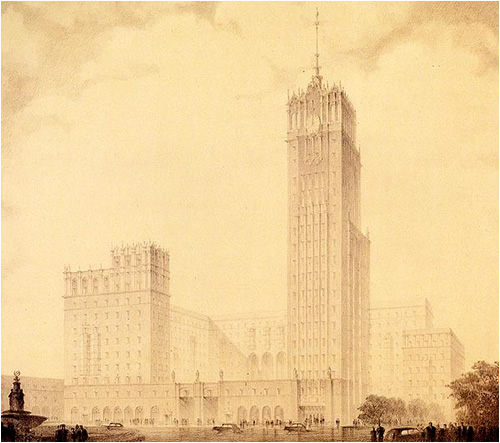
Residental building on Vosstaniya Square.
V.Oltarzhevsky, I.Kuznetsov. 1947
Architects V.Oltarzhevsky and
A.Mordvinov worked together on the plans of the high-rise building of the
Ukraina hotel on Kutuzovsky Prospekt (1954). V.Oltarzhevsky devoted much
time to architectural theory and methods of constructing tall buildings. In
1953 he published a book, High-rise Construction in Moscow, in which
he tried to establish links between this type of architecture and the
traditions of Russian building. He was particularly
interested in the construction and versatility of methods of technically
equipping the "high-rises". Oltarzhevsky's project was never realised. The
tall building on Vosstaniya Square was constructed to a plan by the
architects H. Posokhin and A. Midoyants (1953).
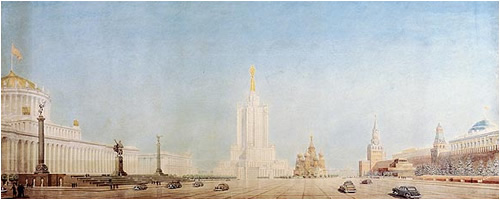
Tall building in Zaryadye. View from the Red Square.
D.Chechulin. 1948
In 1947, the Soviet government
adopted a resolution concerning the construction of high-rise buildings in
Moscow. By the early 1950s, tall buildings had been erected on Lenin Hills
(Moscow State University), the Foreign Ministry on Smolenskaya Square, an
administrative building on Lermontovskaya Square, the "Leningradskaya" and "Ukraina"
hotels on Komsomolskaya Square and Kutuzovsky Prospekt and residential
buildings on Kotelnicheskaya Embankment and Vosstaniya Square. Only the
construction of a 32-floor administrative building in Zaryadye, which was
envisaged as one of the salient features of the silhouette of the central
city skyline, was not completed. Work on it was stopped after the 1955
resolution of the Central Committee, which condemned "excesses and
over-ornamentation in architecture" and signalled a new era in Soviet
architecture. The work which had been done was dismantled, and the hotel "Rossiya"
(also planned by D.Chechulin) was built on the foundations in 1967.
This information is republished here at
the courtesy of The Architecture of Moscow
from the 1930s to the early 1950s: unrealised
projects.
Museum of Architecture, Moscow. |
|
|
 |
![]()